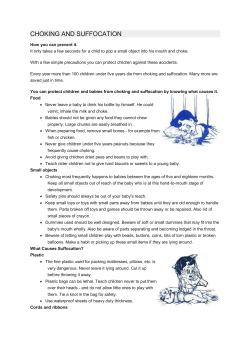
Document 82781
Issue 1 Better option to gripe water Indian Experience Camylofin and paracetamol as a superior therapeutic option in an overfed irritable and crying colicky infant Introduction Dr. Abhishek Bansal MBBS, MD (Ped) Bansal Clinic, Kilkari Shishu Avam Bal Chikitsalaya, Lucknow. An otherwise healthy but excessively crying and irritable baby during the first three months of life is said to have infant colic. It occurs in as many as 40% of infants. The crying episode begins suddenly and often occurs in the evening hours. The crying is usually defined as more than 3 hours per day, more than three times per week, for more than three weeks. Infantile colic causes distress in the child, the parents and the healthcare provider. Infants with colic are difficult or impossible to soothe, no matter what the parents do. There may be periods of quietness, but infants often remain fussy. Crying may end after the infant passes gas or a bowel movement. The causes of infantile colic are not well known and usually spontaneous resolution usually occurs within 3 - 4 months of age. Case Presentation A 2-month old baby (boy) otherwise healthy and thriving baby infant was presented with excessive crying and irritability mainly in the evenings. The child would be normal, but then suddenly the hands closed as in fist making, the legs curl up and the belly seemed swollen as though having apparent belly pain. The child start crying uncontrollably and fails to respond appropriately to normal parenting efforts. The mother said that the child’s belly appeared swollen after feedings and occasionally, there was regurgitation of feeds as well. Local doctor had suggested gripe water to her and she had being using a popular brand of gripe water but that was not beneficial. Clinical Evaluation Head circumference and length were normal for age, but the body weight was more than the 90th centile for his age. The baby’s medical history and symptoms did not reveal suspicious of any other organic pathology or disease. Temperature was normal. There was no lethargy or decreased responsiveness. External examination was normal with no signs of injury. No respiratory distress was evident. ENT examination was normal. Chest was clinically clear. There was no abdominal distension, gastrointestinal symptoms or signs of hernia or intussusception. Investigations Hemogram was normal. Chest and abdominal X-ray were also normal. Urine microscopy was normal and culture did not grow any bacteria. Management The mother was educated about infantile colic and gripe water was discontinued. A Camylofin HCl and paracetamol drop was given, which gave good relief to the baby within the first day itself. These drops can be used to reduce discomfort and the symptoms of colic. This baby was obviously being overfed as the baby seemed to be well otherwise. The parents were educated about problems with overfeeding the baby. The right schedule and amount should be fed to the baby in terms of ounces (for bottle-fed babies) or number of minutes (for breastfed babies). The doctor also suggested measures to soothe and comfort the baby. Parents can try warming the baby’s belly with a warm water bottle or keeping the baby in motion in a rocker or taking the baby for a ride or a walk and making a continuous vibrating-type noise (for example, the noise from a vacuum cleaner or a car engine). These methods help soothe the baby and reduce crying. If the baby is bloated, ‘burp’ the baby frequently. Some babies may be sensitive to proteins in formula. Switching formulas may be important for some babies. Discussion The linking of colic to organic causes has changed its management interventions which include the use of wider range of pharmacological agents such as antispasmodics.1 Camylofin is one of the most potent antispasmodics. It has a mild atropine like anticholinergic action and a direct papaverine like spasmolytic action on the smooth muscle as well. Camylofin causes increase in concentration of cyclic-adenosine monophosphate (cAMP) and thus smooth muscle relaxation by inhibiting the enzyme phosphodiesterase. It has little of no influence on glands, eyes, heart and circulation. It also has very mild anticholinergic side-effects like dryness of mouth, dilatation of pupils, paralysis of accommodation and palpitations. It has a wide margin of safety as the ratio of the effective therapeutic dose to the toxicity dose in animal studies varies from 1:40 - 1:150.2 Paracetamol when given through I.V. administration has been shown to be more effective than I.M. Piroxicam and it is comparable to morphine, diclofenac and ketorolac in treating renal colic.3,4 Taking into consideration its safety profile in children, it is expected that when used it may be effective in pain relief in infantile colic as well. Conclusion An anti-spasmodic such as camylofin in combination with a time tested fast and effective pain reliever such as paracetamol will find good place in treating infantile colic. It delivered the results that were expected. References 1. Savino F, Brondello C, Cresi F, Oggero R, Silvestro L. Cimetropium bromide in the treatment of crisis in infantile colic. J Pediatr Gastroenterol Nutr Apr 2002; 34(4):417-9. 2. Brock N. Pharmacology of avacan. Dtsch Med Wochenschr 1951; 76:474-80. 3. Serinken M, Eken C, Turkcuer I, Elicabuk H, Uyanik E, Schultz CH. Intravenous paracetamol versus morphine for renal colic in the emergency department: A randomized double-blind controlled trial. Emerg Med J 20 Dec 2011. 4. Morgan S. Intravenous paracetamol in patients with renal colic. Emerg Nurse Feb 2011; 18(9):22-5. Dehydration and constipation in an infant causing colicky abdominal pain: A case report Background Infantile colic is not uncommon in clinical practice. The parents are frustrated upon finding an otherwise healthy infant crying continuously. Most parents resort to home remedies and use of over-the-counter available formulations to soothe infants. However, this does not cause enough relief resulting in frustrated parents seeking medical help. Dr. Bharat J Parmar Case Presentation MD,DCH (BOM) Consulting Child Specialist. Mumbai. A 2-month old infant accompanied by her parents presented with nonpassage of stools for 2 days. The parents complained that the child had been crying continuously for the past 3 hours and had been refusing feeds and sips of water also. Attached to: Harkisandas Hospital, Bhatia Hospital, Elizabeth Hospital, Habib Hospital, Saifee Hospital. The mother had tried using the gripe water for a day, but there was no improvement and the infant’s irritability and crying had become worse. Examination • The infant was crying and irritable. The lips and mouth appeared dry. Pulse rate was rapid, but regular. • Systemic examination of cardiovascular and respiratory system was normal. • Abdomen was soft, but on palpation on the right side, slight hardness could be made out. • Anterior fontanelle was normal. Management A provisional diagnosis of constipation, mild dehydration and colicky pain was made and the parents advised to give camylofin dihydrochloride drops (2 - 3 drops) at 4th - 6th hourly intervals. They were advised to give sips of warm water and try to resume breastfeeding once again. They were asked to bring the child again as necessary or after 2 days for a follow-up. After two days, the parents reported that the infant had started suckling again, had passed normal motion two times and was much more comfortable. Discussion Camylofin dihydrochloride drops acts as an effective antispasmodic and provides instant relief in infants with colicky pain.1 An infant with colic is described as one who, otherwise healthy and well-fed, had paroxysms of irritability, fussing or crying that could begin suddenly after feeding.2 The cry is loud and continuous and the spells last from one to four hours. The baby’s face often gets flushed or red. The belly is sometimes distended or prominent and is usually due to accumulation of gas in the abdomen. Refusal to feed due to abdominal cramps can lead to signs of dehydration such as pallor, dry lips and mouth, depressed fontanelle, reduced urine output and constipation.3 This can be relieved by increasing fluid intake and replacement of lost electrolytes to restore fluid balances in mild or moderate dehydration. Commercially available gripe waters are not regulated by the drug regulatory authorities and usually contain a mixture of herbs, bicarbonates and are usually considered as a remedy for colic pain of infants and to soothe crying infants. However, it must be emphasized that gripe water may not be suitable as there is a small chance that the infant could be allergic to one or more of the ingredients.4 References 1. Warke HS, Chauhan AR, Raut VS, et al. A randomized double blind trial of camylofin dihydrochloride. Available at http://www.bhj.org/ journal/2003_4503_july/theefficacy_420.htm. Accessed on16.05.2012 . 3. Dehydration. http://www.faqs.org/health/topics/45/Dehydration.html. Accesed on 16.05.2012. PA 44/5/12 4. How to soothe a crying baby. http://www.webmd.com/parenting/baby/crying-colic-9/colic-remedies. Accessed on 15.05.2012. For the use of a Registered Medical Practitioner or a Hospital or a Laboratory only 2. Colic. http://www.medicinenet.com/colic/page2.htm. Accessed on 16.05.2012. Disclaimer: This scientific issue has been designed and developed by Scientific Press. The matter published herein has been developed by clinicians and medical writers. Although great care has been taken in compiling and checking the contents herein by the concept designer Abbott Healthcare Pvt. Ltd., shall not be responsible in any way for any errors, omissions or inaccuracies in this publication arising from negligence or otherwise however, or for any consequence arising therefrom.
© Copyright 2025

















